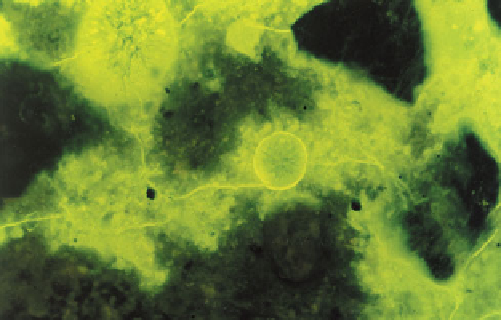Geoscience Reference
In-Depth Information
203
either ettringite or gypsum. TSA differs from
conventional sulfate attack in that the C-S-H of the
cement matrix are attacked by external sulfates to form
thaumasite (CaSiO
3
.CaCO
3
.CaSO
4
.15H
2
O). As the main
C-S-H binding phase of the cement is attacked, TSA
can be more severe than conventional sulfate attack
and, importantly, SRPC offers no protection. In
addition, limestone aggregate particles are also
consumed by TSA.
Thaumasite is believed to form primarily at
temperatures <5-10°C, although evidence is mounting
that it may form even at elevated temperatures (Skalny
et al
., 2002). The replacement of C-S-H by thaumasite
results in softening of the cement matrix into a white,
mushy incoherent mass. In buried concrete elements, TSA
has been found penetrating the outer 50 mm and
exhibiting four distinct zones of gradually decreasing
degradation inwards (Sibbick & Crammond, 1999). The
following zones can be recognized for TSA in hand
specimen and thin section:
•
Zone 1
(outer) - cement paste almost completely
replaced by thaumasite leaving aggregate particles
embedded in soft white mush.
•
Zone 2
(outer middle) - abundant cracks and large
cracks infilled with thaumasite running subparallel
to the outer surface. Haloes of thaumasite around
coarse and fine aggregate particles.
•
Zone 3
(inner middle) - fine thaumasite-filled cracks
running subparallel to the outer surface.
•
Zone 4
(inner) - no evidence of attack in hand
specimen. Needles of thaumasite and sometimes
ettringite filling voids, seen in thin section.
203
Close view of concrete suffering from external
sulfate attack, showing small air voids and
microcracks packed with acicular ettringite crystals
(grey). The uncarbonated cement matrix appears
portlandite depleted (black); XPT, ×150.
204
Figure
205
illustrates the typical appearance of TSA zone
3 in thin section. Ettringite and thaumasite cannot always
be distinguished from examination of thin sections alone,
and if TSA is suspected, optical microscopy should always
204
Fluorescent microscopy of concrete suffering
from external sulfate attack, showing microcracks
(yellow) running through the cement matrix and
connecting with ettringite-filled air voids; UV, ×150.
205
205
Zone 3 TSA showing fine cracks running
subparallel to the outer surface filled with thaumasite
(orange); XPT, ×35.





